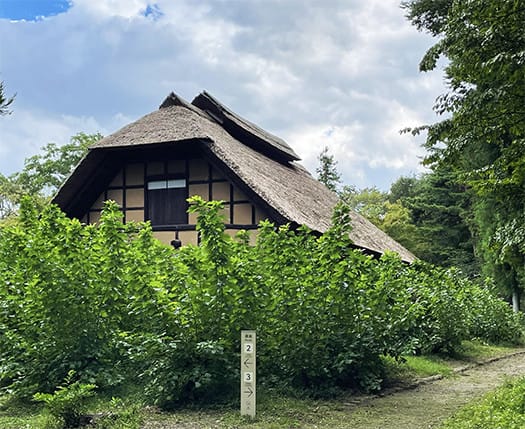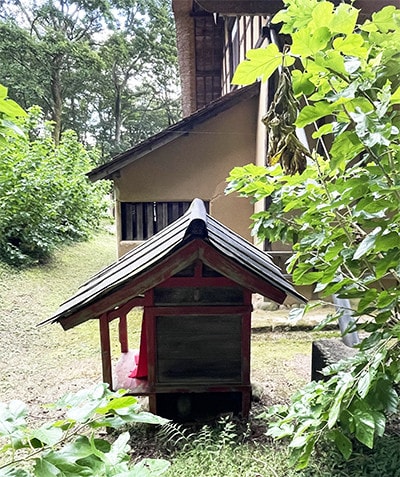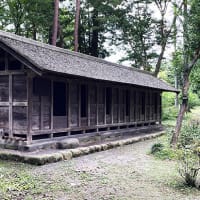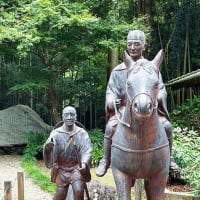


さてようやく日常のワークデスクに戻って、いろいろな連絡事項の進捗確認をしていたら、直近のひとつの交信先から返書が届けられていた。どんな返信かと確認したら、なんともありがたい感想とともにこころよい受諾の内容。ほっとひと安心すると同時に、当方の提供した諸資料も内容を深くご理解いただいたことが伝わってくる文面。
本当に心底がご理解いただけたと感謝。だんだんと伝わってくる心意がありがたい。つくづくと人間のコミュニケーション営為というものに感銘を受けていた。
そういった主要実務の進行の合間に、粛々と6.43GBもの膨大な今回の取材写真データの整理整頓作業に取り組み始めています。写真整理はわたしの個人的な手法・我流でやっているのですが、このプロセスは当然ながら「ナマデータ」と対話しながらのものになる。
その撮影時の空気感、自分がそのときに思っていたことの追体験にもなる。なので、なるべく時間を置かずに自分の「空間記憶」を鮮明化させる大きなポイントだと考えています。
でも、きのう1日で仕掛かり終えた分量は全体の2-3%程度でしょうか。この作業だけでもたぶん1週間程度は掛かりそうであります。でも、住宅取材をながくやってきた人間としては、そのなまなましい「手道具」感が強く感覚させられるものでもあるのですね。
そういうなかで今回のツアーの口切りとしてこの福島市民家園の住居群はあった次第。最初の家はこの養蚕民家。移築前は福島県伊達市にあった旧小野家住宅。江戸期〜明治期から戦前期まで日本の養蚕業は貴重な外貨を稼ぐメイン産業。欧米、とくにフランスで養蚕が不振に陥ったとき、日本の養蚕業が大発展した経緯がある。その養蚕業でも福島県北部地域は最先進地帯だった。北海道の旭川近郊で養蚕農家の古民家を取材したことがあるけれど、たしかその家もこの福島県地域からの移住者だった。
室内に均質な採光を得るために切妻の屋根をカットさせた半切妻(あづま)屋根であり、屋根裏と中2階も蚕室として使われていた。北海道の家もほぼそっくりの構成だった。その建物が桑の葉たちに囲まれて建てられていて、誇らしく、またあたたかく訪問者を迎えてくれていた。

建築年代は1873(明治6)年。世界の市場経済に参入したての日本社会だったけれど、その生産される生糸の量も品質も、いきなり世界レベルのものが出荷された。極東アジアの果ての島国が世界の列強たちに伍して行けたのは、なによりもこのような優しい雰囲気の中から蚕たちが生み出してくれたのだと考えると、味わい深い。建築としても、いかにも民俗性を重厚に訴求してくる。最後の写真は養蚕の民の「祈り」の表徴。
English version⬇
Sericultural silkworm houses in mulberry trees, the power of life that springs from them.
Sericulture, the largest foreign currency earning industry that supported Japanese society from the Edo period and Meiji period to the prewar period. More than a house, it is an “industrial heritage”. The spirit of our ancestors, the heart and soul of Made in Japan. The spirit of our ancestors, the heart and soul of Made in Japan.
Finally, I returned to my work desk and was checking the progress of various communications when I received a reply from one of the most recent correspondents. When I checked what kind of reply I received, I found a heartwarming acceptance with a very grateful impression. I was relieved and at the same time, the letter showed that they deeply understood the contents of the materials we had provided.
We were truly grateful for their deep understanding. I am grateful for the cordiality that is gradually being conveyed to me.
I was deeply impressed by the appreciation of human communication activities.
In between the progress of these major tasks, I have started to organize the huge 6.43 GB of photo data from this project. I am organizing the photos in my own way, but this process naturally involves talking to the “real data.
It is also a way to relive the atmosphere of the shoot and what I was thinking at the time. So I consider it a major point to clarify my “spatial memory” with as little time as possible.
But the amount I finished working on in one day yesterday was probably about 2-3% of the total. This work alone will probably take about a week. However, as someone who has been covering housing for a long time, I feel a strong sense of the “hand tools” that are used in this project.
The houses in the Fukushima City Minka-en were the first stop on this tour. The first house was this silkworm farmhouse. Before its relocation, it was the former Ono family residence in Date City, Fukushima Prefecture. From the Edo and Meiji periods to the prewar period, sericulture in Japan was a main industry that earned valuable foreign currency. When sericulture was in slump in Europe and the United States, especially in France, the Japanese sericulture industry made great progress. The northern part of Fukushima Prefecture was the most advanced region in the sericultural industry. I once visited an old sericultural farmhouse near Asahikawa in Hokkaido, and I believe that the family had migrated from the Fukushima area.
The house had a half-gabled roof that was cut off to allow for uniform lighting inside the house, and the attic and mezzanine floor were used as a silkworm room. The house in Hokkaido was almost exactly the same configuration. The building was proudly and warmly welcoming visitors, surrounded by mulberry leaves.
The building was constructed in 1873. Although Japanese society had just entered the global market economy, the quantity and quality of the raw silk produced was suddenly world-class. It is fascinating to think that an island nation on the edge of Far East Asia was able to compete with the world powers thanks above all to the silkworms produced in such a gentle atmosphere. As an architectural structure, it also has a profound folkloric appeal.The last photo is a symbol of the “prayer” of the sericultural people.




























※コメント投稿者のブログIDはブログ作成者のみに通知されます